红火蚁入侵对香蕉园节肢动物群落的负面效应研究
2017-09-16陆永跃
王 磊,王 正,曾 玲,陆永跃
(华南农业大学红火蚁研究中心,广州 510642)
红火蚁入侵对香蕉园节肢动物群落的负面效应研究
王 磊,王 正,曾 玲,陆永跃
(华南农业大学红火蚁研究中心,广州 510642)
为了探索红火蚁SolenopsisinvictaBuren入侵对南方典型旱作生态系统-香蕉种植园节肢动物群落的生态学效应,本文采用定点系统调查、采样的方法,收集、记录了红火蚁严重发生的高、中和低杂草覆盖度香蕉园香蕉植株上、杂草上、地表节肢动物种类、个体数量,并比较了节肢动物群落动态变化、多样性主要参数与红火蚁未发生区之间的差异。研究结果表明在红火蚁入侵区,高、中覆盖度类型区域香蕉植株上物种数有所增加,低覆盖类型物种数减少;高覆盖度类型区域香蕉植株上节肢动物个体总数增加,而中、低覆盖度类型均呈下降趋势,其中低覆盖度下降幅最大,为38.01%。与无红火蚁区域相比,红火蚁入侵区高、中和低杂草覆盖度区域香蕉植株上节肢动物群落特征参数变化不大。与对照区域相比,入侵区高、中、低杂草覆盖度区域杂草上节肢动物群落物种数降幅均大于30%,个体总数降幅均大于50%,丰富度指数降低了20%,而优势度指数分别增加了25%、37.5%、62.5%;入侵区地表节肢动物群落物种数降幅均近30%,个体总数降幅均在34%以上,丰富度指数降低了20%,高、中、低覆盖度区域地表节肢动物群落优势度指数分别上升了46.15%、61.54%、38.46%。红火蚁入侵对高、中、低杂草覆盖度香蕉园香蕉植株上节肢动物群落的负面影响较小,而对杂草和地表节肢动物群落有显著负面影响,改变了这些地方节肢动物群落的特征和结构。
红火蚁;香蕉园;入侵;节肢动物群落;杂草覆盖度;生态学影响
红火蚁SolenopsisinvictaBuren是一种危险性检疫害虫,对公共安全、人体健康、农牧业和生态环境等方面有重大影响(Lofgrenetal.,1975;Moloney and Vanderwoude,2003;Allenetal.,2004;Oietal.,2004;Xuetal.,2012)。2003年10月中国台湾、2004年9月大陆发现红火蚁发生为害(曾玲等,2005a;Wangetal.,2013),其后该蚁迅速传播,速度为48-80 km/年;截止2014年12月被侵入的县级区域数量已超过230个,而且已经进入快速扩散蔓延期,未来可能侵入的区域将更为广泛(陆永跃等,2008;陆永跃,2014;陆永跃和曾玲,2015)。
红火蚁通过捕食无脊椎动物、攻击地栖性脊椎动物,或者通过食物资源竞争,造成无脊椎动物和一些地栖性脊椎动物数量和多样性锐减(Hu and Frank,1996;Allenetal.,2001;Wojciketal.,2001;Morrison,2002)。红火蚁取食的无脊椎动物种类很多,且包括卵、幼虫、蛹和成虫等各发育阶段(Stiles and Jones,2001)。该蚁入侵对无脊椎动物种群发展造成了不利影响,间接导致生态系统内生物和非生物因子的变化(Folgarait,1998)。尤其是具相近生态位和生态功能的许多土著蚂蚁种类很可能因为红火蚁的入侵而灭绝(Hook and Porter,1990;Porter and Savignano,1990)。
自发现其发生危害后,该蚁入侵对我国生态系统的影响成为了入侵生物学界关注的重点内容之一。在华南地区,该蚁食谱较宽,其弃尸堆中包括了8个目昆虫和种子共41个种类(许益镌等,2008),昆虫纲动物占其总固体食物46%左右(张波等,2008)。红火蚁入侵显著改变了玉米地蜘蛛的类群结构,入侵区域蜘蛛种类、多样性指数和均匀度指数随着红火蚁入侵时间增大而逐渐降低(黄俊等,2012)。红火蚁通过刮啃、搬运、丢弃等方式对多种蔬菜、旱粮作物种子造成较严重威胁(黄俊等,2010;黄俊等,2014),还改变了植物如藿香蓟Ageratumconyzoides等空间分布格局(Huangetal.,2011a)。与新入侵地具近似生态位、生态功能的物种—土著蚂蚁类群之间关系成为了红火蚁入侵效应研究中关注的重点,从个体竞争行为和能力到种群数量之间关系、入侵过程中蚂蚁类群结构变化、对无脊椎动物群落的影响等方面均开展了观察,总的结论是就群体而言红火蚁具有较强的竞争能力,且在较简单的生态系统中该蚁更易通过竞争排挤其他蚂蚁、捕食无脊椎动物,降低本地蚂蚁类群多样性,降低群落多样性,可成为蚂蚁类群中绝对优势种(吴碧球等,2008;宋侦东等,2010;吴碧球等,2010;席银宝等,2010;高燕等,2011;吴碧球等,2014;Wuetal.,2014a)。例如,在被红火蚁入侵的草坪生境和荒草地生境中本地蚂蚁丰富度分别降低了46%、33%(Luetal.,2012)。该蚁的入侵还对本地蚂蚁与产蜜露昆虫的共生关系及一些捕食者的功能发挥产生了负面影响(Huangetal.,2010;Huangetal.,2011b;Zhouetal.,2013a;Zhouetal.,2013b;Zhouetal.,2014),红火蚁与蚜虫共生关系还会显著降低作物产量(Wuetal.,2014b)。红火蚁可以与新入侵我国的扶桑绵粉蚧PhenacoccussolenopsisTinsley建立共生关系(Zhouetal.,2012a),保护其免受天敌攻击(Zhouetal.,2012b),并促进其传播扩散(周爱明等,2014;Zhouetal.,2015)。
华南地区生态系统多样性丰富,红火蚁入侵的生境类型也是多种多样的(李宁东等,2006),在不同生境中该蚁入侵对节肢动物群落的影响应存在不同。本文以香蕉园生态系统为研究对象,通过调查研究,明确红火蚁入侵和未入侵香蕉园内节肢动物群落差异,揭示红火蚁入侵对香蕉园生态系统节肢动物的影响,为全面评估该蚁入侵中国南方的生态效应提供科学依据。
1 材料和方法
1.1 试验地生境
试验在广东省广州市增城新建香蕉园进行(东经113.63°,北纬23.24°)。该地属于亚热带海洋季风气候。该香蕉园面积0.54 ha,按常规方法进栽培管理。该园与周围农田间有约0.8-1 m宽水沟,因此,隔离度较好,受外界环境影响较小。
表1试验香蕉园各小区安排
Table1Schematicdiagramaboutexperimentalbananaplantation

根据调查,该区域香蕉园红火蚁为多蚁后型(周爱明等,2011)。根据地面杂草覆盖度和是否有红火蚁发生将香蕉地分成4种类型区域:高覆盖度类型、中覆盖度类型、低覆盖度类型和对照。各类型区域情况如下:(1)高覆盖度类型:有红火蚁发生,基本任由杂草生长,覆盖度保持在70%以上;(2)中覆盖度类型:有红火蚁发生,定期铲除部分杂草,保持覆盖度30%-70%;(3)低覆盖度类型:有红火蚁发生,经常铲除杂草,可以有零星杂草存在,保持覆盖度在30%以下;(4)对照区:无红火蚁发生,地面杂草覆盖度保持在70%以上。每个类型区域设6个小区,每个小区面积140 m2-160 m2(表1)。各小区小气候、土质等生态环境一致。
试验前调查各个小区红火蚁活蚁巢密度和工蚁数量,发现每个小区内活蚁巢密度为每100 m27-10个、每个诱饵上工蚁数量为100-200头,为重度发生(王福祥等,2009;周爱明等,2011)。同时在试验中,每月调查记录1次各个小区活蚁巢数量,使用诱饵法调查记录工蚁数量,明确红火蚁发生程度变化(周爱明等,2011)。
1.2 试验方法
1.2.1节肢动物群落调查方法
1.2.1.1 香蕉植株
采用系统调查方法。每类型区域随机调查3个小区,每个小区标定5株香蕉。调查时先环绕香蕉植株一周目测、记录活动性较大的节肢动物,然后仔细查看活动性较弱的附着在香蕉植株上的节肢动物。记录香蕉植株上节肢动物种类、数量,采集标本带回实验室鉴定。调查时间为2008年5月到2008年10月。每月调查1次。
1.2.1.2 杂草
采用扫网方法调查。捕虫网(扫网)口径为30 cm,扫网幅度范围约2 m左右,左右扫动1次为1网,每次调查每个小区往复扫10网。每类型区域6个小区全部调查。收集捕虫网中节肢动物并置于盛有75%酒精的塑料瓶中保存,在实验室观察、记录种类和数量。调查时间为2007年11月到2008年10月。每月调查1次。
1.2.1.3 地表
采用掉落式陷阱法调查。具体设置方式如下:将长15 cm、直径3 cm塑料离心管埋入地下,管口与地面平齐,向管中加入50%酒精至1/3高度处。每个小区按照四角方形设置4个采样点,样点间距8-10 m,每个采样点设4个陷阱,按间隔1 m口字型排列。每类型区域6个小区全部调查。陷阱放置24 h后回收,取出节肢动物放入盛有75%酒精的塑料瓶中保存,带回实验室观察、记录种类和数量。调查时间为2007年11月到2008年10月。每月调查1次。
1.2.2节肢动物群落特征分析方法
采用Simpson优势度公式、Shannon-Wiener多样性公式、Pielou均匀度公式和物种丰富度公式计算优势度指数(C)、多样性指数(H′)、均匀度指数(E)和物种丰富度指数(R)(赵志模和郭依泉,1990;马克平和钱迎倩,1994)。
物种数或者个体数变化(%)=(对照区物种数或者个体数-其他区域物种数或者个体数)/对照区物种数或者个体数×100。
上述数据均采用SPSS 18.0软件进行统计分析。
2 结果与分析
2.1 红火蚁入侵对香蕉植株上节肢动物群落的影响
香蕉植株上节肢动物种类比较少,共采集到43科53种,其主要种类属于膜翅目(25%)、鞘翅目(19%)、半翅目(16%)、双翅目(10%)、鳞翅目(10%)、蜘蛛目(9%)和直翅目(3%),其他类别约占8%。膜翅目和鞘翅目的种类之和约占总节肢动物种类的一半(44%)。主要节肢动物有跳蛛、球腹蛛、猫蛛、冠网蝽、弄蝶、蓑蛾、刺蛾、长角立毛蚁、黄立毛蚁、黄蜂、粉虱、蚜虫、食蚜蝇、叶甲、瓢甲等。
5月到10月4种类型区域香蕉植株上节肢动物物种数量均大致呈增长趋势,对照区变化较为平缓,高、中、低覆盖度类型区域前期变化较大,后期趋于稳定。与对照相比,不同调查时间高、中、低覆盖度类型的物种数不呈简单的增长或减少的变化,而是有增有减,这可能与某类昆虫的物种数量变化有关系,例如6月膜翅目种类显著增大。总体看,无论红火蚁是否入侵发生,香蕉植株上节肢动物种类数均未发生显著变化,对照区物种数多次调查结果平均为14.83个,高、中、低覆盖度区域则分别为18.33个、16.67个、14.00个,4个类型区域间无显著差异(表2)。结果表明,红火蚁入侵对香蕉植株上节肢动物种类数影响较小。
5月到10月,无论是对照还是高、中、低三种覆盖度类型区域,香蕉植株上节肢动物个体总数总体均呈下降趋势,对照和高、中覆盖度类型区域下降幅度均超过了50%。与对照相比,除高覆盖度类型外,中、低覆盖度类型区域节肢动物个体数绝大部分情况下较少。例如6月,中、低覆盖度区域数量分别少了51.12%、65.92%(表3)。虽然香蕉植株上有些物种没有由于被红火蚁入侵完全被排挤出香蕉园,但是它的种群数量则明显被抑制。
对香蕉植株上节肢动物群落进行分析,获得各个指数(表4)。结果显示,红火蚁入侵对3种类型区域香蕉植株上节肢动物群落负面影响较小。与对照相比,高、中、低覆盖度区域节肢动物群落物种除了优势集中性指数呈小幅度降低外,丰富度、多样性指数、均匀度指数均表现为一定程度增大。
2.2 红火蚁入侵对香蕉园杂草上节肢动物群落的影响
香蕉园杂草上的节肢动物种类较多,共采集到94科147种,其中半翅目和双翅目昆虫种类所占比例较高,分别为21%和18%,其他各目由多到少依次为膜翅目(15%)、蜘蛛目(13%)、鞘翅目(13%)、直翅目(7%)、鳞翅目(8%),其他目类群约占5%。主要节肢动物有猫蛛、跳蛛、草地逍遥蛛、白条据足蛛、迷宫漏斗蛛、黑斑盖蛛、盲蝽、荔蝽、长蝽、缘蝽、飞虱、叶蝉、蚜虫、瓢甲、蠓、蚊、小花蝇、大蚊、菌蚊、瘿蚊、水虻、蝗虫、蟋蟀、立毛蚁等20多种。由表5可知,四种类型区域香蕉园杂草上节肢动物的动态趋势相似,1月后随着气温的逐步升高,香蕉园的昆虫活动增加,蜘蛛目和双翅目的种类较多。特别是7月以后,节肢动物数目大大增加。对照区的物种数多次调查结果平均为37.33个,高、中、低覆盖度区域则分别为25.75个,25.17个和24.83个(表5);红火蚁发生的3种类型香蕉园杂草上的节肢动物物种数量均显著低于对照区域。比如,在高覆盖度区域,7月28日和8月16日调查的物种数比对照减少50%和52.27%。结果表明,红火蚁入侵可显著降低香蕉园杂草上节肢动物种类数。

表2 4种类型区域香蕉植株上节肢动物群落物种数比较
注:表中数据为平均值±标准误,同行数据后不同字母表示差异显著(P<0.05)。下同。Note: Same letters indicated there is no significant difference (P<0.05). The same below.
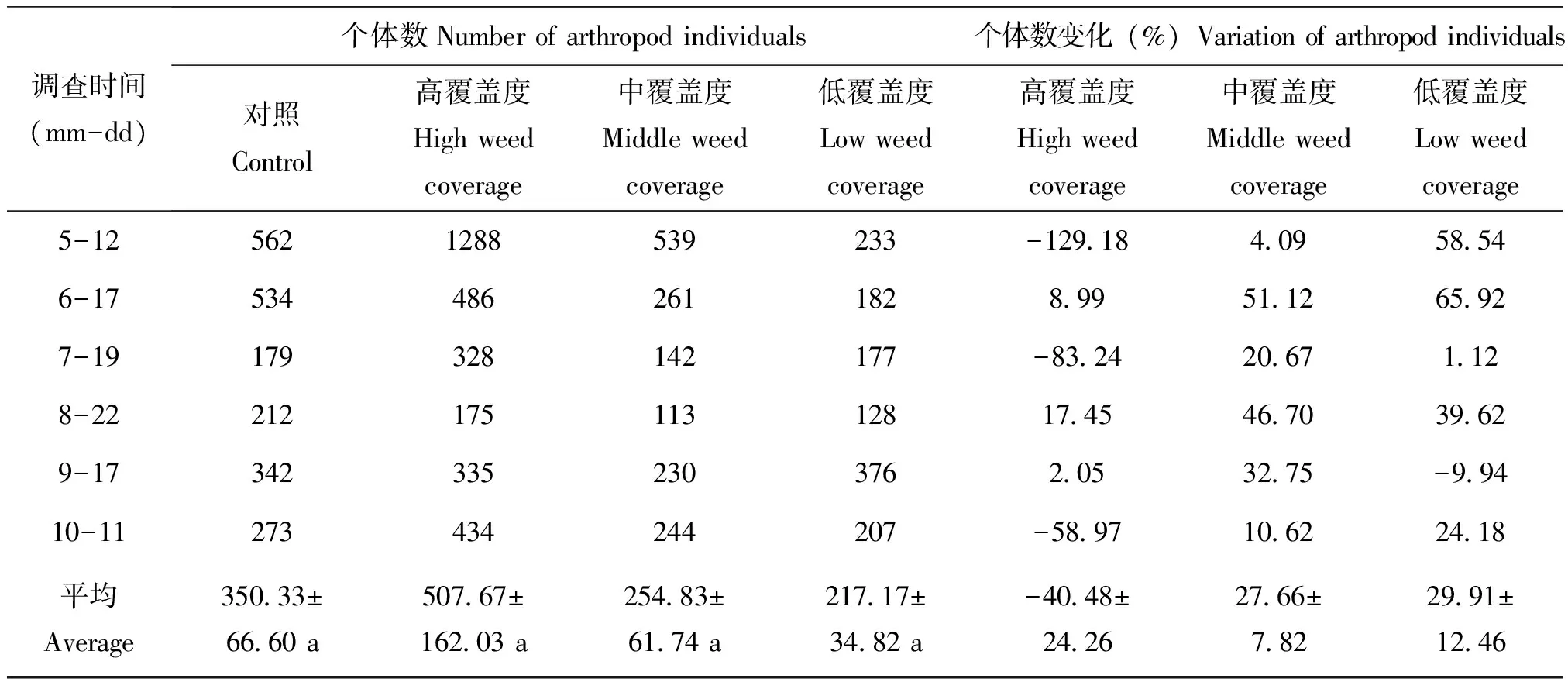
表3 4种类型区域香蕉植株上节肢动物群落个体数比较

表4 红火蚁入侵对香蕉植株上节肢动物群落特征影响
注:S,物种数;N,个体数;R,物种丰富度;H′,多样性指数;C,优势集中性指数;E,均匀度指数。下同。Note: S, Species number; N, Individual sum;R, Species richness;H′, Species diversity index;C, Dominant concentration;E, Evenness index. The same below.
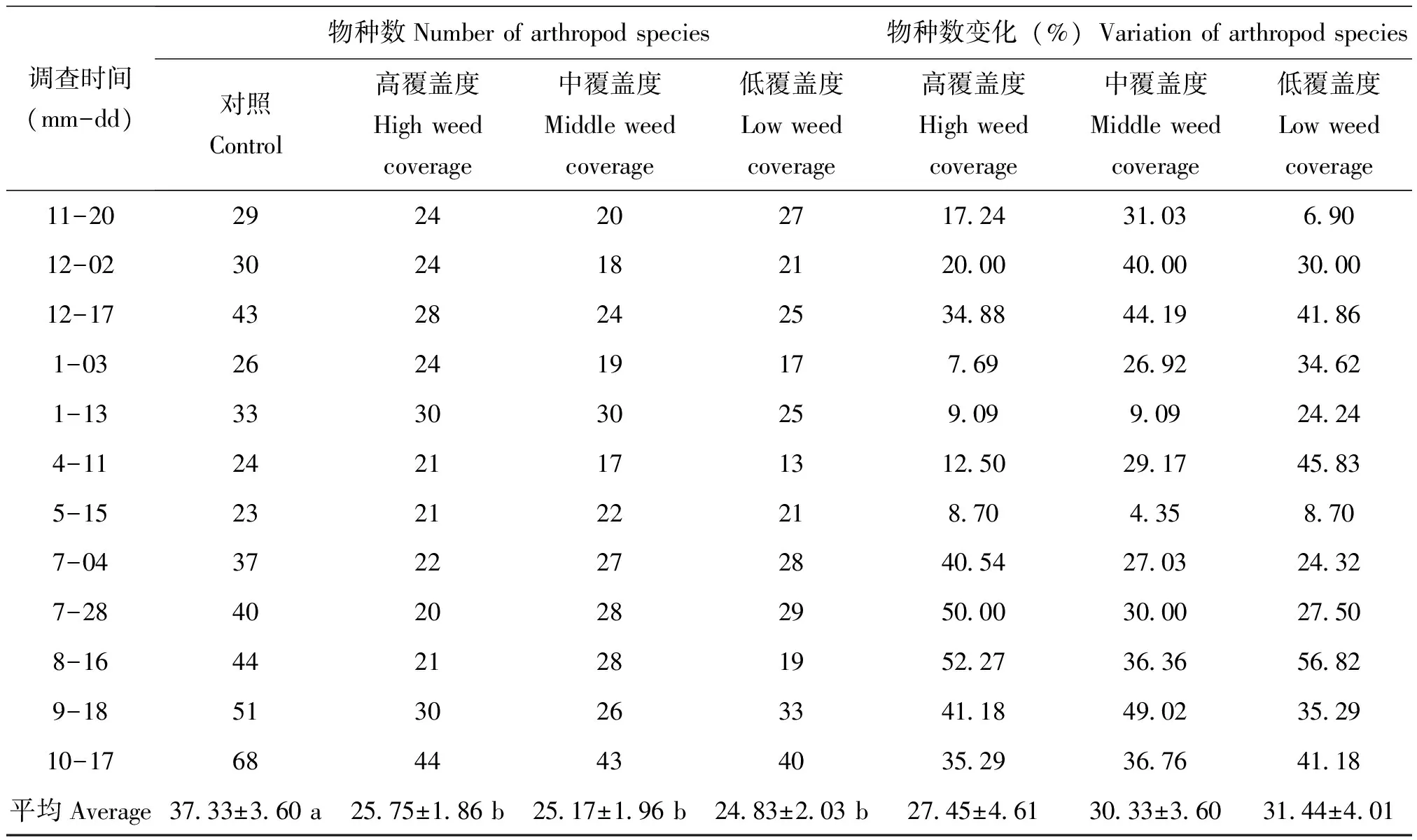
表5 4种类型区域香蕉园杂草上节肢动物群落物种数比较
与对照香蕉园相比,无论是高覆盖度类型,中覆盖度类型,还是低覆盖度类型,杂草上每个月节肢动物物种个体数均呈下降趋势。例如8月的高、中、低覆盖度区域内杂草上的节肢动物数量分别减少了73%、67.51%和75.95%。高、中、低覆盖度区域内杂草上的物种数量多次调查结果平均分别为130.17个、139个和134个,显著低于对照区的279.33个(表6)。虽然有些物种并没有被红火蚁完全消灭,但其种群数量则明显被抑制,因红火蚁捕食包括卵、幼虫、蛹和成虫在内的各个生命阶段的节肢动物,使得这些节肢动物的存活率显著降低,导致某些物种迁出实验地,或者在一个较低的水平生存。
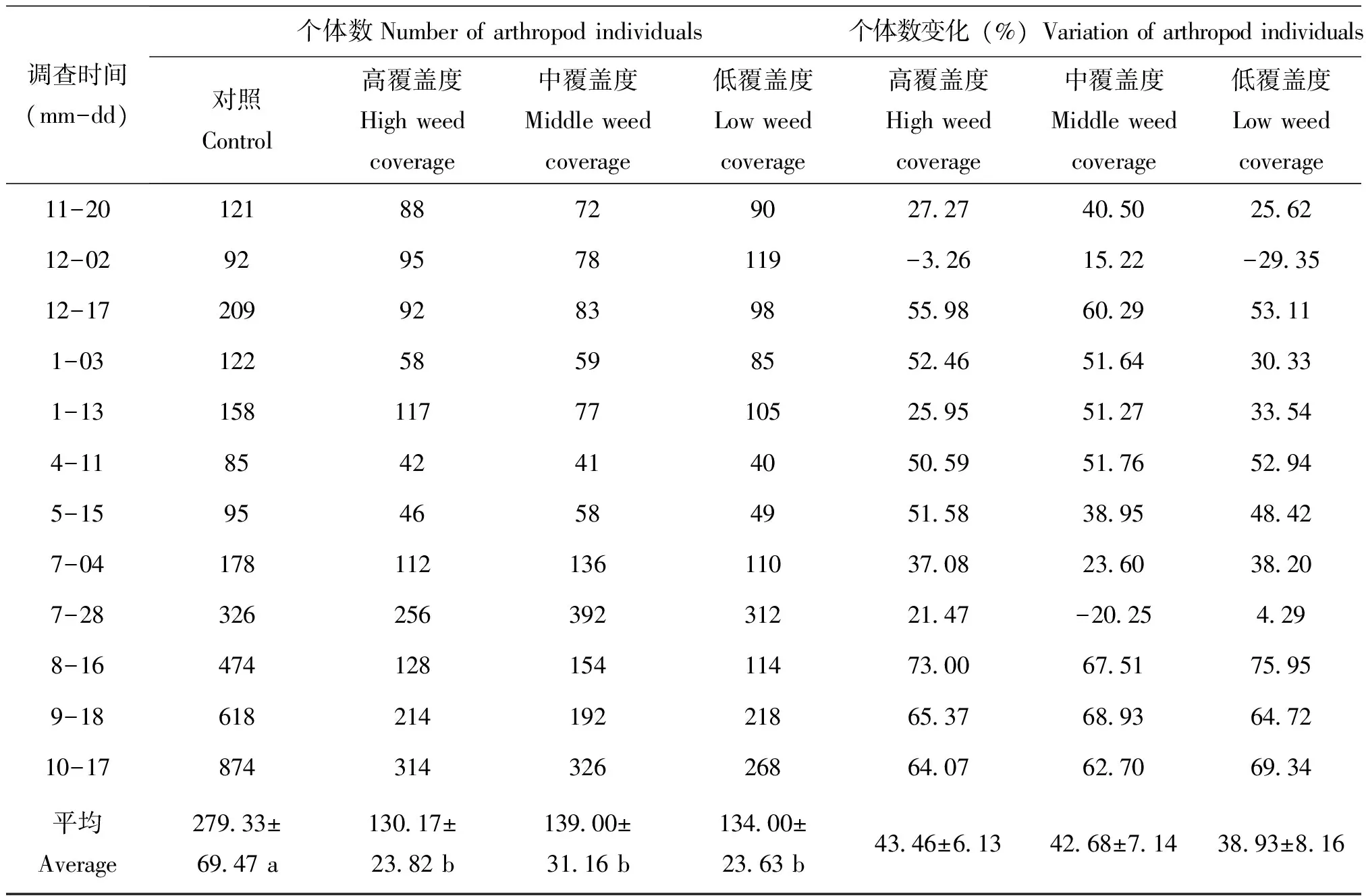
表6 4种类型区域香蕉园杂草上节肢动物群落个体数比较
对4种类型香蕉园杂草上节肢动物群落进行分析,获得各个指数(表7)。结果显示,与对照相比,3种覆盖度类型蕉园内杂草上节肢动物群落的物种数、个体总数、物种丰富度指数都出现了大幅下降,多样性指数及均匀度指数也有所降低,而优势度指数升高。3类蕉园杂草上节肢动物群落物种数降幅均大于30%,个体总数降幅均大于50%;高、中和低覆盖度3种类型蕉园杂草上节肢动物群落优势度上升,增幅分别为25%、37.5%及62.5%。以上结果说明,红火蚁对3类香蕉园杂草上的节肢动物群落造成了较显著的负面影响。
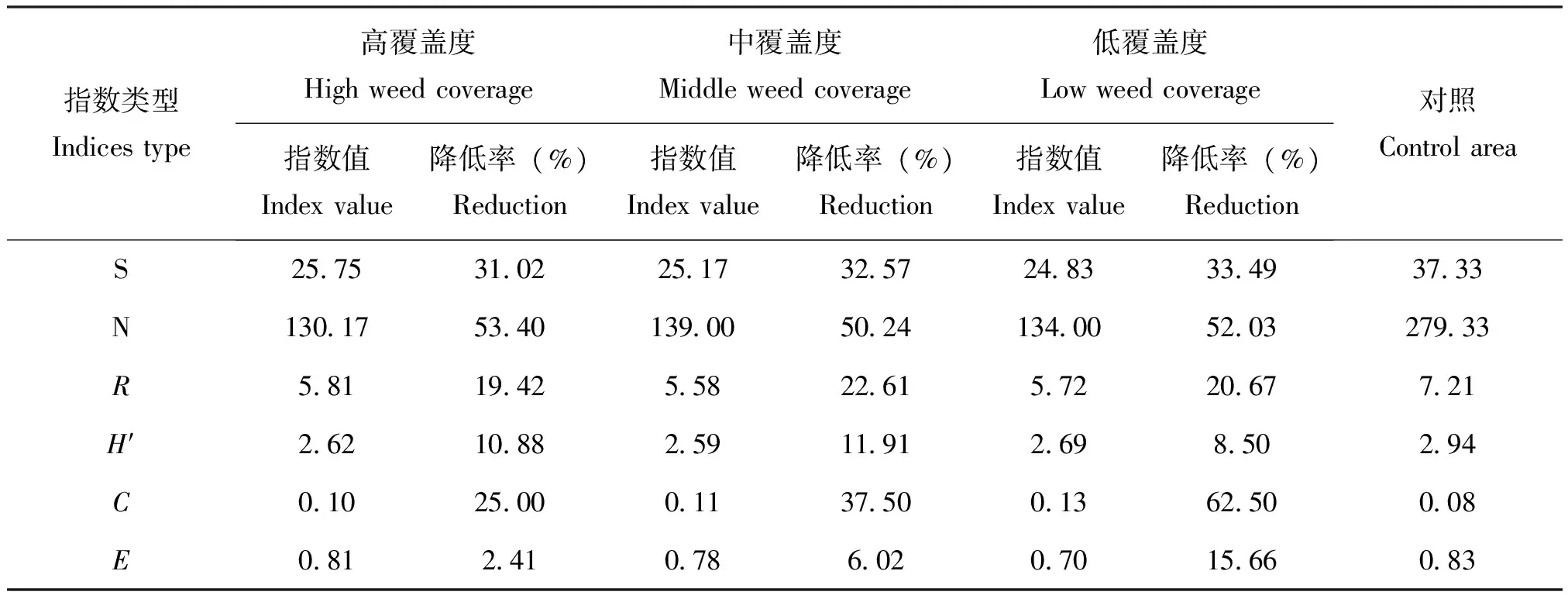
表7 红火蚁入侵对香蕉园杂草上节肢动物群落特征影响
2.3 红火蚁入侵对香蕉园地表节肢动物群落的影响
用陷阱法调查香蕉园地表节肢动物,共获得共60科93种,其中主要类群为半翅目(21%)、鞘翅目(17%)、蜘蛛目(16%)、膜翅目(14%)、双翅目(10%)、直翅目(5%)、蜚蠊目(4%)和鳞翅目(4%),其他类群占9%。但是各类节肢动物群落物种数量多不一定个体数量多,如膜翅目昆虫物种数并不是最多的,但是其个体数量最多。1年的香蕉地地面调查总共采集到节肢动物113种。其中主要的节肢动物有哀弓背蚁、黄立毛蚁、长角立毛蚁、黑头酸臭蚁、迷宫漏斗蛛、管巢蛛、猫蛛、盖蛛、草地逍遥蛛、蚜虫、飞虱、叶蝉、蟋蟀、露尾甲、蝇、癭蚊、弹跳虫等。
对照区域、高覆盖度、中覆盖度和低覆盖度4种类型区域香蕉园地表节肢动物种类数分别为15.83个、11个、10.42个和11.25个(表8)。与对照区比较,高、中、低覆盖度香蕉园地表节肢动物物种数均呈现显著下降趋势,高覆盖度类型下降幅度一般在20%-40%,平均下降29.79%;中覆盖度类型下降幅度在20%-50%,平均下降34.56%;低覆盖度类型的下降幅度在10%-40%,平均下降26.32%。结果表明,红火蚁入侵显著降低了香蕉园地表节肢动物种类数。

表8 4种类型区域香蕉园地表节肢动物群落物种数比较
由表9可以看出,红火蚁对香蕉园地表节肢动物群落的个体数具有显著的负面影响。高覆盖度、中覆盖度和低覆盖度4种类型区域香蕉园地表节肢动物种类数分别为37.25个、35.92个和42.33个,显著低于对照区域的64.67个(表8)。在高覆盖度类型,节肢动物群落个体数减退率一般在30%-50%,最大有66.67%,平均为29.79%;中覆盖度类型个体数减退率的减退率可达83.58%,平均为34.56%;低覆盖度类型的个体数减退率一般在10%-40%,最高可达76.92%,平均为26.32%。由此可见,红火蚁能显著降低香蕉园节肢动物群落个体数量。
对香蕉园地表节肢动物群落进行分析,获得各个指数(表10)。结果显示,红火蚁入侵队3种类型蕉园内地表节肢动物群落有显著的负面影响。与对照组相比,高、中、低覆盖度的香蕉园内地表节肢动物群落的物种数、个体总数、多样性指数、均匀度指数及物种丰富度指数均出现不同程度的下降,而优势度指数上升。3类蕉园地表节肢动物群落物种数降幅近30%,个体总数降幅在34%以上,优势度指数上升幅度分别为46.15%、61.54%及38.46%。
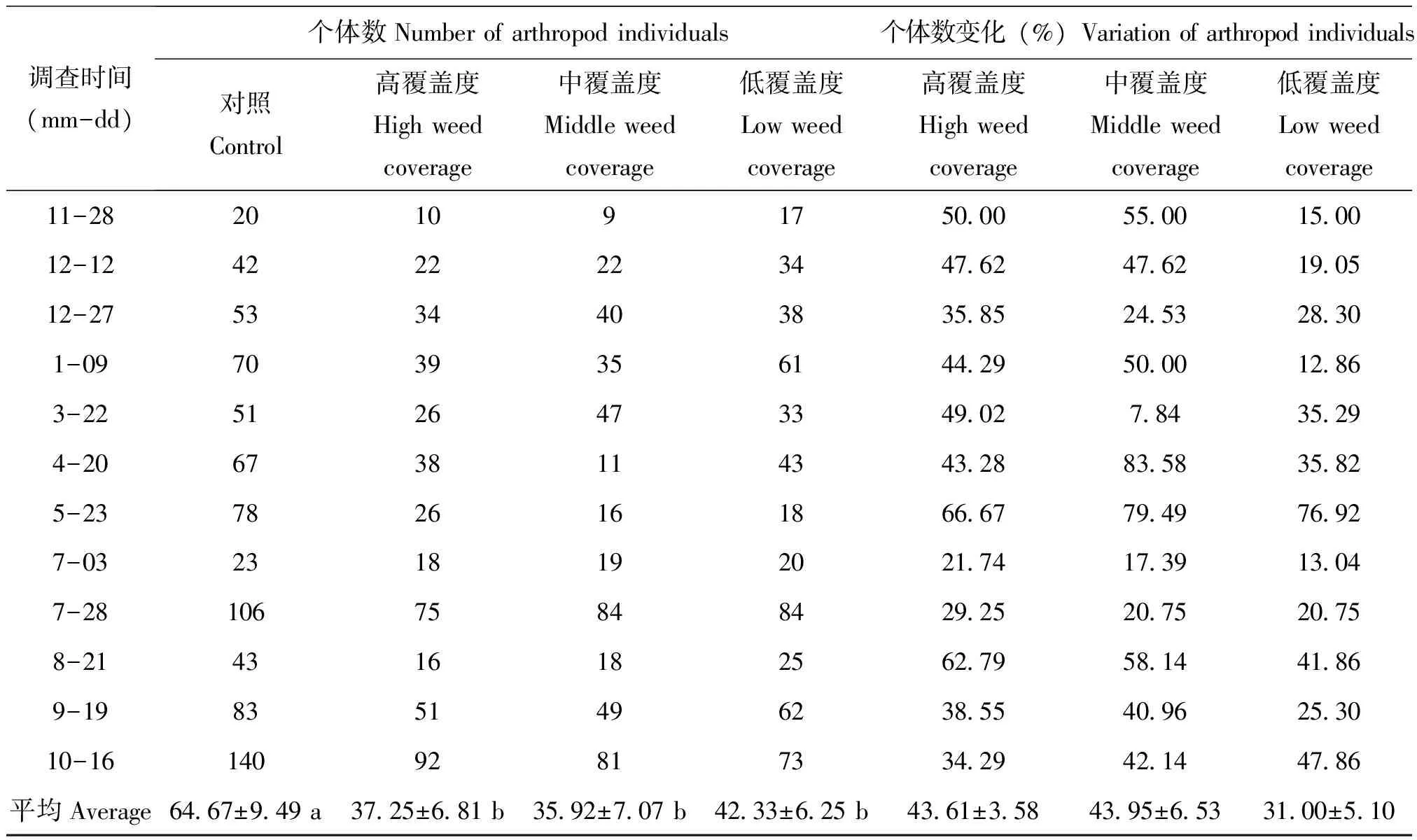
表9 4种类型区域香蕉园地表节肢动物群落个体数比较
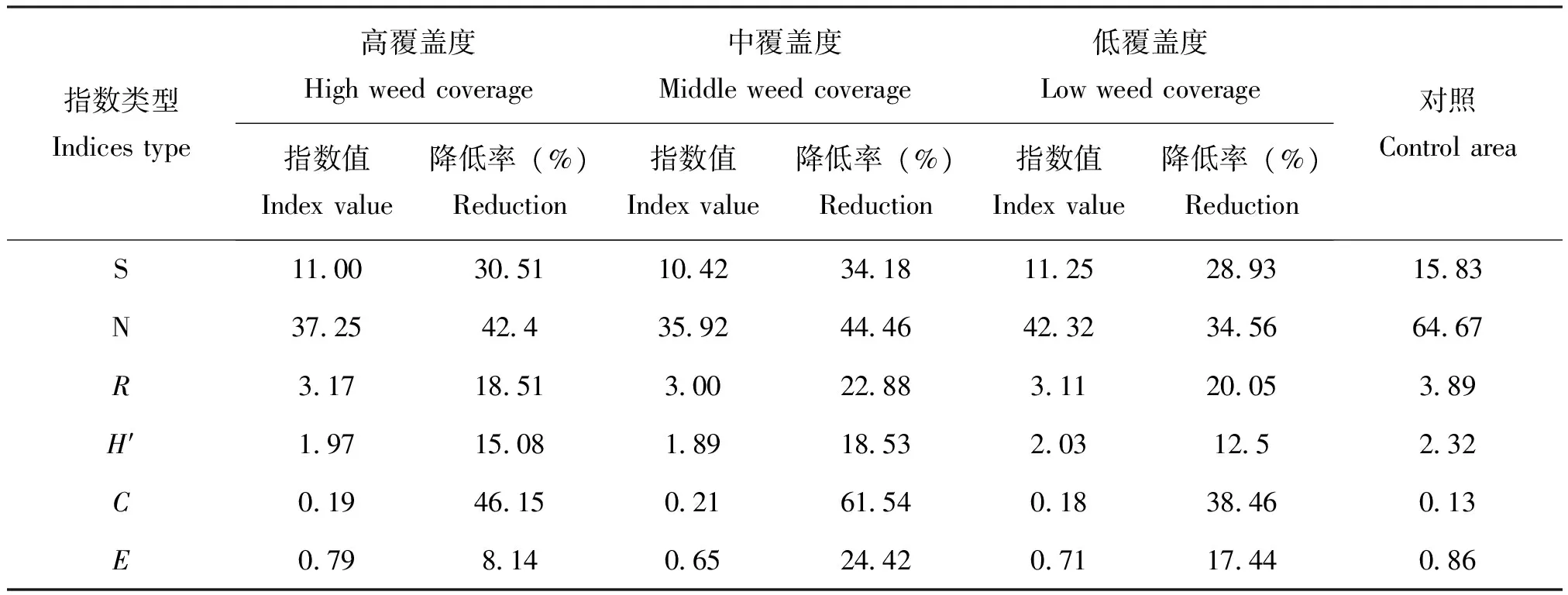
表10 红火蚁入侵对香蕉园地表节肢动物群落特征影响
3 结论与讨论
红火蚁入侵对当地无脊椎动物、脊椎动物及其它蚂蚁造成的破坏和不利影响是导致生物多样性丧失的主要原因之一(Vinson,1997)。红火蚁不仅能在地表取食,也能在树木上取食,并且可能会影响到林冠层节肢动物。对荔枝园的研究发现,红火蚁的入侵可以导致荔枝园树冠、地表植被、地表及土壤中的无脊椎动物群落的物种数和个体数出现明显下降(席银宝等,2010)。本研究发现红火蚁通过抑制或排挤香蕉园内节肢动物的方式改变香蕉园食物链的网络结构。入侵后,红火蚁虽然对香蕉园内香蕉植株上节肢动物群落造成较小的负面影响,但是对香蕉园杂草和地表上节肢动物群落造成显著的负面影响。
King and Tschinkel(2013)和Tschinkel and King(2013)根据对松林生态系统的长期调查认为红火蚁的入侵程度与生境被破坏程度相关,增加生物系统多样性可以降低红火蚁对生态系统造成的影响。而本研究也发现类似现象,即杂草覆盖度与节肢动物群落指数的变化存在一定关系。在低覆盖度杂草的香蕉园内,杂草上节肢动物群落优势度和均匀度指数变化幅度较高覆盖度香蕉园大。原因可能是当香蕉园的杂草覆盖度较高时,可以为香蕉地增加有机质,调节香蕉园小环境的温度和湿度,为节肢动物的生活提供更多选择,在一定程度上增强了群落的稳定性,扩大了生态容量,延缓了红火蚁对生物多样性的破坏进程。
调查中发现,虽然红火蚁可以捕食香蕉植株上的节肢动物,但其对香蕉植株上节肢动物的种类及多样性等的负面影响有限,某些昆虫并不会因为红火蚁的捕食而被全部驱赶出香蕉植株。在高、中覆盖度的香蕉园,随着温度的逐渐升高,香蕉植株上的节肢动物群落物种数反而有一定的增长。调查中还发现,红火蚁可以大量捕食香蕉的主要害虫-香蕉弄蝶和香蕉冠网蝽。国外也有研究证实红火蚁是甘蔗螟DiatraeasaccharalisFab、甜菜夜蛾SpodopteraexiguaHübner和棉铃虫Helicoverpazea(Boddie)的重要天敌(Reaganetal.,1972;Bessin and Ragan,1989;Kaspari,2000)。Harvey and Eubanks(2004)研究发现生境复杂度可以提高红火蚁对甘蓝地中害虫的生物防治效能。因此,在红火蚁入侵的香蕉园内,通过提高香蕉园的生境复杂度(例如:高、中覆盖度香蕉园),或许可以达到在不影响生物群落的情况下,降低香蕉园害虫-香蕉弄蝶和香蕉冠网蝽的种群。但是红火蚁工蚁是贪婪的杂食性捕食者,除害虫外也攻击益虫。同时红火蚁通过与蚜虫的互利共生使香蕉植株上的蚜虫种类和数量增加。弄清红火蚁对害虫和益虫的影响,就可以区分红火蚁对害虫的直接捕食作用和由于对有益昆虫的捕食而造成的生物控制的潜在损失,进而可以评估红火蚁在抑制其它害虫时作为生物控制物的效能。
香蕉园杂草生境是一个较复杂的生态系统,红火蚁入侵会改变其结构和功能。红火蚁对香蕉园节肢动物的影响主要是在觅食的过程中发生的,由于香蕉园杂草较多,节肢动物种类繁多,这为红火蚁提供了丰富的食料,许多杂草成为红火蚁经常光顾的地方。红火蚁一方面竞争占据香蕉园杂草上节肢动物的生态位,使其失去生存空间,另一方面红火蚁与香蕉园杂草上的物种竞争食物或直接杀死其上的节肢动物,影响香蕉园里节肢动物的生存。在红火蚁入侵地,红火蚁形成大面积的单优势群,同时通过捕食减少了杂草上物种的种类和数量,降低了物种多样性,使依赖与当地物种多样性生存的其他物种没有适宜的栖息环境,这些都是导致香蕉园杂草上节肢动物群落多样性下降的原因。但是由于生态系统有一定的自我修复功能,所以节肢动物群落的种类和数量有时也会有一定程度的回升。
香蕉园地表节肢动物是香蕉园生态系统中食物链的重要组成部分,它担负着消费者和分解者的多重角色。地表节肢动物群落特征和多样性的变化都是对地表生境变化的一种响应。许多物种由于红火蚁的较强的竞争替代作用而种群数量减少,或者逃离受红火蚁危害的香蕉园。这不仅是因为红火蚁是一种群居地栖性的害虫,更重要的红火蚁是一种杂食性的害虫,有很强的攻击性。红火蚁不仅改变了香蕉园地表节肢动物群落的组成,还导致其群落区系的单一化。与对照区相比,高、中和低植物覆盖度类型的地表生态系统在结构和功能方面都趋于贫乏;高、中和低植物覆盖度的节肢动物物种数、个体总数、多样性指数、均匀度指数及丰富度指数均有较大程度的下降。红火蚁入侵对香蕉园地表节肢动物群落带来较大影响,其中对本地蚂蚁的影响更是严重。红火蚁入侵香蕉园后很快在数量占据了绝对优势,迅速成为优势种。与对照相比,在有红火蚁发生的香蕉园内,只诱集到了5种本地蚂蚁,分别为黄立毛蚁Paratrechinaflavipes(Smith)、长角立毛蚁Paratrechinalongicornis(Latreille)、黑头酸臭蚁Tapinomamelanocephalum(Fabricius)和哀弓背蚁CamponotusdolendusForel,本地蚂蚁不仅种类减少,数量也锐减。此结果与Luetal.(2012)等在其他生境的调查结果相似。红火蚁入侵改变了本地蚂蚁群落结构,对香蕉园生物群落产生了较严重的负面影响。
References)
Allen CR, Epperson DM, Garmestani AS. Red imported fire ant impacts on wildlife: A decade of research [J].AmericanMidlandNature, 2004, 152 (1): 88-103.
Allen CR, Lutz RS, Lockley T,etal. The non-indigenous ant,Solenopsisinvicta, reduces loggerhead shrike and native insect abundance [J].JournalofAgriculturalandUrbanEntomology, 2001, 18 (4): 249-259.
Bessin RT, Ragan TE. Cultivar resistance and arthropod predation of sugarcane borer (Lepidoptera: Pyralidae) affects incidence of deadhearts inLouisianasugarcane[J].JournalofEconomicEntomology, 1989, 86 (3): 929-923.
Folgarait PJ. Ant biodiversity and its relationship to ecosystem functioning:A review [J].BiodiversityConversation, 1998, 7 (9): 1221-1244.
Gao Y, Lü LH, He YR,etal. Interference competition between the red imported fire ant (SolenopsisinvictaBuren) and two native ant species (Hymenoptera: Formicidae) [J].ActaEntomologicaSinica, 2011, 54 (5): 602-608. [高燕, 吕利华, 何余容, 等. 红火蚁与两种本地蚂蚁间的干扰竞争[J]. 昆虫学报, 2011, 54 (5): 602-608]
Harvey CT, Eubanks MD. Effects of habitat complexity on biological control by the red imported fire ant (Hymenoptera: Formicidae) in collards [J].BiologicalControl, 2004, 29 (3): 348-358.
Hook AW, Porter SD. Destruction of harvester ant colonies by invading fire ants (Hymenoptera: Formicidae) in south-central Texas [J].SouthwestNaturalist, 1990, 35 (4): 477-478.
Hu GY, Frank JH. Effect of red imported fire ant (Hymenoptera: Formicidae) on dung-inhabiting arthropods in Florida [J].EnvironmentalEntomology, 1996, 25 (6): 1290-1296.
Huang J, Xu YJ, Liang GW,etal. Effects on the germination of two dry land crop seeds ofSolenopsisinvictaBuren [J].JournalofBiosafety, 2014, 23 (2): 88-92. [黄俊, 许益镌, 梁广文, 等. 红火蚁对2种旱地作物种子萌发的影响[J]. 生物安全学报, 2014, 23 (2): 88-92]
Huang J, Xu YJ, Lu YY,etal. Effects of red imported fire ants,Solenopsisinvicta(Hymenoptera: Formicidae) on the relationship between native ants andAphiscraccivora(Hemiptera: Aphididae) in mungbean fields [J].Sociobiology, 2010, 55 (2): 415-425.
Huang J, Xu YJ, Lu YY,etal. Effects ofSolenopsisinvictainvasion on the diversity of spider communities in a corn field [J].ChineseJournalofAppliedEcology, 2012, 23 (4): 1111-1116. [黄俊, 许益镌, 陆永跃, 等. 红火蚁入侵对玉米地蜘蛛类群多样性的影响[J]. 应用生态学报, 2012, 23 (4): 1111-1116]
Huang J, Xu YJ, Lu YY,etal. Effects of the invasive antSolenopsisinvicta(Hymenoptera: Formicidae) onMenochilussexmaculatus(Coleoptera: Coccinellidae) as a predators ofAphiscraccivora(Hemiptera: Aphididae) in laboratory conditions [J].Sociobiology, 2011, 57 (3): 565-574.
Huang J, Xu YJ, Zeng L,etal. Changes to the spatial distribution ofAgeratumconyzoides(Asterales: Asteraceae) due to red imported fire antsSolenopsisinvicta(Hymenoptera: Formicidae) in China [J].JournalofInsectBehavior, 2011, 24 (4): 307-316.
Huang J, Xu YJ, Zeng L,etal. Selective feeding ofSolenopsisinvictaon seeds of eight plant species and their influences on germination [J].JournalofEnvironmentalEntomology, 2010, 32 (1): 6-11. [黄俊, 许益镌, 曾玲, 等. 红火蚁对8种植物种子的选择性取食及其对种子萌发的影响[J]. 环境与昆虫学报, 2010, 32 (1): 6-11]
Kaspari M. Do imported fire ants impact canopy arthropods? Evidence from simple arboreal pitfall traps [J].SouthernNaturalist, 2000, 45 (2): 118-122.
King JR, Tschinkel WR. Experimental evidence for week effects of fire ants in a naturally invaded pine-savanna ecosystem in north Florida [J].EcologicalEntomology, 2013, 38 (1): 68-75.
Li ND, Lu YY, Zeng L,etal. Study on types of environment, spatial ditribution and sampling of red imported fire antSolenopsisinvicta Buren active mounds in Wuchuan, Guangdong province [J].JournalofHuazhongAgriculturalUniversity, 2006, 25 (1): 31-35. [李宁东, 陆永跃, 曾玲, 等. 广东省吴川红火蚁生境类型、空间分布和抽样技术研究[J]. 华中农业大学学报, 2006, 25 (1): 31-35]
Lofgren CS, Banks WA, Glancey BM. Biology and control of imported fire ants [J].AnnualReviewofEntomology, 1975, 20 (20): 1-30.
Lu YY, Liang GW, Zeng L. Study on expansion pattern of red imported fire ant,SolenopsisinvictaBuren, in south China [J].ScientiaAgriculturaSinica, 2008, 41 (4): 1053-1063. [陆永跃, 梁广文, 曾玲. 华南地区红火蚁局域和长距离扩散规律研究[J]. 中国农业科学, 2008, 41 (4): 1053-1063]
Lu YY, Wu BQ, Xu YJ,etal. Effects of red imported fire ants (Solenopsisinvicta) on the species structure of several ant communities in South China [J].Sociobiology, 2012, 59 (1): 275-286.
Lu YY, Zeng L. 10 years after red imported fire ant found to invade China: History, current situation and trend of its infestation [J].PlantQuarantine, 2015, 29 (2): 1-6. [陆永跃, 曾玲. 发现红火蚁入侵中国10年: 发生历史、现状与趋势[J]. 植物检疫, 2015, 29 (2): 1-6]
Lu YY. Long-distance spreading speed and trend prediction of red imported fire ant,SolenopsisinvictaBuren, in mainland China [J].GuangdongAgriculturalScience, 2014, 41 (10): 70-72. [陆永跃. 中国大陆红火蚁远距离传播速度探讨和趋势预测[J]. 广东农业科学, 2014, 41 (10): 70-72]
Ma KP, Qian YQ. Theory and Method of Research of Biodiversity [M]. Beijing: China Science and Technology Press, 1994. [马克平, 钱迎倩. 生物多样性研究的原理与方法[M]. 北京: 中国科学技术出版社, 1994]
Moloney SD, Vanderwoude C. Potential ecological impacts of red imported fire ants in eastern Australia [J].JournalofAgricultural&UrbanEntomology, 2003, 20 (3): 131-142.
Morrison LW. Long-term impacts of an arthropod-community invasion by the imported fire ant,Solenopsisinvicta[J].Ecology, 2002, 83 (8): 2337-2345.
Oi DH, Watson CA, Williams DF. Monitoring and management of red imported fire ants in a tropical fish farm [J].FloridaEntomologist, 2004, 87 (4): 522-527.
Porter SD, Savignano DA. Invasion of polygyne fire ants decimates native ants and disrupts arthropod community [J].Ecology, 1990, 71 (6): 2095-2106.
Reagan TE, Coburn G, Hensley SD. Effects of mirex on the arthropod fauna of a Louisiana sugarcane field [J].EnvironmentalEntomology, 1972, 1 (5): 588-591.
Song ZD, Lu YY, Xu YJ,etal. Dynamic of native ants on the lawn with the invasion ofSolenopsisinvictaBuren [J].ActaEcologicaSinica, 2010, 30 (5): 1287-1295. [宋侦东, 陆永跃, 许益镌, 等. 红火蚁入侵草坪过程中蚂蚁类群变动趋势[J]. 生态学报, 2010, 30 (5): 1287-1295]
Stiles JH, Jones RH. Top down control by the red imported fire ant (Solenopsisinvicta) [J].AmericanMidlandNaturalist, 2001, 146 (1): 171-185.
Tschinkel WR, King JR. The role of habitat in the persistence of fire ant populations [J].PloSONE, 2013, 8 (10): e78580.
Vinson SB. Invasion of the red imported fire ant (Hymenoptera: Formicidae):Spread, biology and impact [J].AmericanEntomology, 1997, 43 (1): 23-39.
Wang FX, Wang L, Li XN,etal. National standard: Guidelines for quarantine surveillance ofSolenopsisinvictaBuren GB/T23626-2009 [S]. Beijing: Standards Press of China, 2010. [王福祥, 王琳, 李小妮, 等. 红火蚁疫情监测规程GB/T23626-2009 [S]. 北京: 中国标准出版社, 2010]
Wang L, Lu YY, Xu YJ,etal. The current status of research onSolenopsisinvictaBuren (Hymenoptera: Formicidae) in mainland China [J].AsianMyrmecology, 2013, 5 (1): 125-138.
Wojcik DP, Allen CR, Brenner RJ,etal. Red imported fire ants: Impact on biodiversity [J].AmericanEntomologist, 2001, 47 (1): 16-23.
Wu BQ, Liang GW, Xu YJ,etal. Interference competition between newly invading red imported fire ants,SolenopsisinvictaBuren and the resident antTapinomamelanocephalumF. in wasteland and lychee orchards [J].JournalofBiosafety, 2014, 23 (2): 97-102. [吴碧球, 梁广文, 许益镌, 等. 荒草地和荔枝园生境短期入侵的红火蚁与黑头酸臭蚁种间的干扰竞争[J]. 生物安全学报, 2014, 23 (2): 97-102]
Wu BQ, Lu YY, Liang GW,etal. Influence of the red imported fire ant,SolenopsisinvictaBuren (Hymenoptera: Formicidae) on the diversity of ant communities in a newly infested longan orchard and grass areas nearby [J].ActaEcologicaSinica, 2010, 30 (7): 2075-2083. [吴碧球, 陆永跃, 梁广文, 等. 红火蚁对新入侵龙眼园和荒草地蚂蚁类群多样性的影响[J]. 生态学报, 2010, 30 (7): 2075-2083]
Wu BQ, Lu YY, Zeng L,etal. Influences ofSolenopsisinvictaBuren invasion on the native ant communities in different habitats in Guangdong [J].ChineseJournalofAppliedEcology, 2008, 19 (1): 151-156. [吴碧球, 陆永跃, 曾玲, 等. 红火蚁入侵对广东多种生境中蚂蚁类群的影响[J]. 应用生态学报, 2008, 19 (1): 151-156]
Wu BQ, Wang L, Liang GW,etal. Food competition mechanism betweenSolenopsisinvictaBuren andTapinomamelanocephalumFabricus [J].Sociobiology, 2014, 61 (3): 265-273.
Wu D, Zeng L, Lu YY,etal. Effects ofSolenopsisinvicta(Hymenoptera: Formicidae) and its interaction with aphids on the seed productions of mungbean and rapeseed plants [J].JournalofEconomicEntomology, 2014, 107 (5): 1758-1764.
Xi YB, Lu YY, Liang GW,etal. Effects of the red imported fire ant (RIFA),SolenopsisinvictaBuren, on diversity and stability of invertebrate community in litchi orchards [J].ActaEcologicaSinica, 2010, 30 (8): 2084-2099. [席银宝, 陆永跃, 曾玲, 等. 红火蚁对荔枝园无脊椎动物群落多样性及稳定性的影响[J]. 生态学报, 2010, 30 (8): 2084-2099]
Xu YJ, Huang J, Zhou AM,etal. Prevalence ofSolenopsisinvicta(Hymenoptera: Formicidae) venom allergic reactions in mainland China [J].FloridaEntomologist, 2012, 95 (4): 961-965.
Xu YJ, Zeng L, Lu YY,etal. Food content of refuse piles of the red imported fire ant,SolenopsisinvictaBuren (Hymenoptera: Formicidae) [J].ActaEcologicaSinica, 2008, 41 (4): 1053-1063. [许益镌, 曾玲, 陆永跃, 等. 红火蚁弃尸堆的食物结构[J]. 生态学报, 2008, 41 (4): 1053-1063]
Zeng L, Lu YY, Chen ZN. Survey and Control for Red Imported Fire AntSolenopsisinvictaBuren [M]. Guangzhou: Guangdong Science and Technology Press, 2005. [曾玲, 陆永跃, 陈忠南. 红火蚁监测与防治[M]. 广州: 广东科技出版社, 2005]
Zeng L, Lu YY, He XF,etal. Identification of red imported fire antSolenopsisinvictato invade mainland China and infestation in Wuchuan, Guangdong [J].ChineseBulletinofEntomology, 2005, 42 (2): 144-148. [曾玲, 陆永跃, 何晓芳, 等. 入侵中国大陆的红火蚁的鉴定及发生为害调查[J]. 昆虫知识, 2005, 42 (2): 44-48]
Zhang B, He YR, Chen T,etal. Dietary composition of foragers of the red imported fire ant,SolenopsisinvictaBuren (Hymenoptera: Formicidae) in two habitats, mulberry orchard and barren land, in South China [J].ActaEntomologicaSinica, 2015, 58 (4): 382-390. [张波, 何余容, 陈婷, 等. 华南地区桑园和荒地两种生境中红火蚁觅食工蚁的食物组成[J]. 昆虫学报, 2015, 58 (4): 382-390]
Zhao ZM, Guo YQ. Pruniciple and Methods of Community Ecology [M]. Chongqing: Science, Technology and Literature Press, 1990. [赵志模, 郭依泉. 群落生态学原理与方法[M]. 重庆: 科学技术文献出版社重庆分社, 1990]
Zhou AM, Liang GW, Lu YY,etal. Interspecific competition between the red imported fire ant,SolenopsisinvictaBuren and ghost ant,TapinomamelanocephalumFabricius for honeydew resources produced by an invasive mealybug,Phenacoccussolenopsis Tinsiley [J].Arthropod-PlantInteractions, 2014, 8 (5): 469-474.
Zhou AM, Liang GW, Zeng L,etal. Fire ant (Solenopsisinvicta) invasion assists the short-range spread of another invasive insect, the cotton mealybugPhenacoccussolenopsis [J].JournalofBiosafety, 2014, 23 (2): 93-96. [周爱明, 梁广文, 曾玲, 等. 红火蚁入侵对棉花粉蚧近距离扩散的促进作用[J]. 生物安全学报, 2014, 23 (2): 93-96]
Zhou AM, Lu YY, Zeng L,etal. Does mutualism drive the invasion of two alien species? The case ofSolenopsisinvictaandPhenacoccussolenopsis[J].PLoSONE, 2012, 7 (7): e41856.
Zhou AM, Lu YY, Zeng L,etal. Effect of host plants on the honeydew production of an invasive mealybug,Phenacoccussolenopsis(Hemiptera: Pseudococcidae) [J].JournalofInsectBehavior, 2013, 26 (2): 191-199.
Zhou AM, Lu YY, Zeng L,etal.Solenopsisinvicta(Hymenoptera: Formicidae), defendPhenacoccussolenopsis(Hemiptera: Pseudococcidae) against its natural enemies [J].EnvironmentalEntomology, 2013, 42 (2): 247-252.
Zhou AM, Wang Z, Zeng L,etal. Dynamics of red imported fire antSolenopsisinvictaBuren in banana plantations [J].JournalofEnvironmentalEntomology, 2011, 33 (4): 466-470. [周爱明, 王正, 曾玲, 等. 香蕉园内红火蚁种群时序动态规律研究[J]. 环境昆虫学报, 2011, 33 (4): 466-470]
Zhou AM, Wu D, Liang GW,etal. Effects of tending bySolenopsisinvicta(Hymenoptera: Formicidae) on the sugar composition and concentration in the honeydew of an invasive mealybug,PhenacoccusSolenopsis(Hemiptera: Pseudococcidae) [J].Ethology, 2015, 121 (5): 492-500.
Zhou AM, Zeng L, Lu YY,etal. Fire ants protect mealybugs against their natural enemies by utilizing the leaf shelter constructed by a leaf roller,Syleptaderogata[J].PLoSONE, 2012, 7 (11): e49982.
Negativeeffectsofredimportedfireant(SolenopsisinvictaBuren)invasiononarthropodcommunityinthebananaplantations
WANG Lei,WANG Zheng, ZENG Ling, LU Yong-Yue*
(Red Imported Fire Ant Research Center, South China Agricultural University, Guangzhou 510642, China)
In order to explain the ecological effect of the red imported fire antSolenopsisinvictaBuren invasion on the arthropod communities at southern China typical ecosystem-banana plantations, the methods of systematic investigation and sampling were used to collect and record the arthropod species and quantity on the banana plants, weeds and ground surface at the fire ant invading and non-invading banana plantations with high, medium and low coverages of weeds in this paper. Based on the above data, the dynamic changes and difference of arthropod communities and main parameters of arthropod diversity between the invaded and non-invaded plantations were compared. The results showed that, at the fire ant infestation area, the number of arthropod species on banana plants increased to some extent at the banana plantations with high and medium weed coverage, and that decreased at banana plantations with low weed coverage; at the plantations with high weed coverage, the total number of arthropod individual on banana plants increased, while those at the plantations with medium and low weed coverage showed a downward trend, among which the maximum decrease was 38.01% at the low weed coverage area. Compared with the control, at the fire ants infestation area, the parameters of arthropod community on banana plants at the plantations with high, medium and low weed coverage changed little. With the non-invasion area of the fire ants, at the fire ant invaded area the number of arthropod species on weeds at the plantations with high, medium and low weed coverage all declined more than 30%, and the total number of arthropod individuals all declined more than 50%, and richness index decreased by 20%, while the dominance index increased by 25%, 37.5%, and 62.5%, respectively. At the fire ant invasion area, the number of arthropod species on the ground surface all fell nearly 30%, and the total number of individuals all declined more than 34%, and richness index decreased by 20%, and dominance index increased by 46.15%, 61.54%, and 38.46%, respectively at the plantaions with high, medium and low weed coverage. At the banana plantations with high, medium and low weed coverage, the negative effect of fire ant invasion on arthropod communities of the banana plants was slight, but significant on the weeds and ground. Due to fire ant invasion, the characteristics and structure of the arthropod community on the weeds and ground were changed obviously.
SolenopsisinvictaBuren; invasion; banana plantation; arthropod community; weed coverage; ecological impact
科技基础性工作专项(2006FY111000);国家重点研发计划项目(2016YFC1201200);广东省科技计划项目(2017B020202009)
王磊,男,1986年生,安徽阜阳人,博士,研究方向为昆虫生态学和害虫防治,E-mail:wanglei1107@outlook.com
*通讯作者Author for correspondence, E-mail: luyongyue@scau.edu.cn
Received: 2017-04-06; 接受日期Accepted: 2017-05-28
Q968;S435.6
:A
1674-0858(2017)04-0835-13
王磊,王正,曾玲,等.红火蚁入侵对香蕉园节肢动物群落的负面效应研究[J].环境昆虫学报,2017,39(4):835-847.
